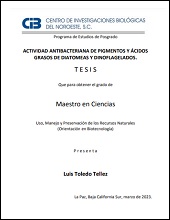| dc.contributor.advisor | ESTRADA MUÑOZ, NORMA ANGELICA | |
| dc.contributor.advisor | Arredondo Vega, Bertha Olivia | |
| dc.contributor.author | Toledo Tellez, Luis | |
| dc.date.issued | 2023 | |
| dc.identifier | https://cibnor.repositorioinstitucional.mx/jspui/handle/1001/2723 | |
| dc.identifier.uri | http://dspace.cibnor.mx:8080/handle/123456789/3169 | |
| dc.description.abstract | "Un uso indiscriminado de antibióticos en los sistemas acuícolas marinos es una de las causantes de que las bacterias patógenas presenten multi-resistencia. Los ácidos grasos y pigmentos fotosintéticos se han identificado como compuestos bioactivos con potencial antibacteriano. Los dinoflagelados y diatomeas son microalgas que producen variedad de pigmentos y son productores de ácidos grasos que suelen constituir del 15 al 25% de su biomasa. El objetivo fue evaluar el potencial antibacteriano de extractos de lípidos y pigmentos totales de los dinoflagelados Alexandrium margalefii y Gymnodinium catenatum, y las diatomeas Odontella aurita y Nanofrustulum shiloi, contra las bacterias Vibrio parahaemolyticus, Escherichia coli y Staphylococcus aureus. Los microorganismos se cultivaron en medios específicos y en condiciones de laboratorio. La cuantificación de lípidos totales (LT), ácidos grasos y pigmentos fue realizada por espectrofotometría, cromatografía de gases (GC-FID) y cromatografía de líquidos (HPLC-DAD), respectivamente. La actividad antibacteriana fue evaluada por el método de resazurina. El pigmento que predominó en las cuatro microalgas fue la clorofila a, y en las diatomeas se identificó la fucoxantina y en dinoflagelados la peridinina, así como el β-caroteno que se presentó en menor porcentaje. A. margalefii tuvo el mayor porcentaje de lípidos totales, así como el de ácidos grasos saturados. G. catenatum y O. aurita la mayoría de sus ácidos grasos fueron poliinsaturados, y en N. shiloi fueron los ácidos grasos monoinsaturados. Los pigmentos de G. catenatum inhibieron a E. coli en un 28-60%. Los extractos lipídicos de A. margalefii y G. catenatum inhibieron un 87% y 89% respectivamente a S. aureus; los LT de O. aurita y N. shiloi, inhibieron a E. coli en un 50% y 65%; V. parahaemolyticus fue inhibida en un 33.6 % con los LT de A. margalefii. Se presentó una mayor efectividad de los extractos contra bacterias Gram positivas, lo cual podría estar dado por las diferencias que existen en la estructura y composición de la pared celular de las bacterias." | es |
| dc.format | pdf | es |
| dc.language.iso | spa | es |
| dc.publisher | Centro de Investigaciones Biológicas del Noroeste, S.C. | es |
| dc.rights | Acceso abierto | es |
| dc.subject | microalgas, antibacterianos, pigmentos, ácidos grasos | es |
| dc.subject | microalgae, antibacterial, pigments, fatty acids | es |
| dc.subject.classification | BACTERIOLOGÍA | es |
| dc.title | ACTIVIDAD ANTIBACTERIANA DE PIGMENTOS Y ÁCIDOS GRASOS DE DIATOMEAS Y DINOFLAGELADOS | es |
| dc.type | masterThesis | es |
| dc.dirtesis.grado | Maestría en Ciencias en el Uso, Manejo y Preservación de los Recursos Naturales | es |
| dc.dirtesis.disciplina | Biotecnología | es |
| dc.dirtesis.universidad | Centro de Investigaciones Biológicas del Noroeste, S.C. | es |
| dc.dirtesis.facultad | Posgrado en Recursos Naturales | es |
| dc.description.abstracten | "Indiscriminate use of antibiotics in marine aquatic systems could result in pathogen bacteria showing multi-resistance. Fatty acids and photosynthetic pigments have been identified as potentially antibacterial bioactive compounds. Dinoflagellates and diatoms are microalgae that produce a variety of pigments as well as fatty acids. The latter usually constitute from 15% to 25% of their biomass. The objective was to assess the antibacterial potential of lipid extracts and total pigments from the dinoflagellates Alexandrium margalefii and Gymnodinium catenatum and from the diatoms Odontella aurita and Nanofrustulum shiloi against the bacteria Vibrio parahaemolyticus, Escherichia coli and Staphylococcus aureus. The microorganisms were cultivated in specific media and laboratory conditions. The quantification of Total Lipids (LT), Fatty Acids and pigments was carried out by spectrophotometry, gas chromatography (GC-FID) and liquid chromatography (HPLC-DAD) respectively. Antibacterial activity was assessed by the resazurin method. The predominant pigment in the four microalgae was chlorophyll a, in the diatoms fucoxanthin was identified as well as peridinin in dinoflagellates, β-carotene appeared but in a lower percentage. A. margalefii had the higher total lipids percentage and saturated fatty acids. About G. catenatum and O. aurita most of their fatty acids were polyunsaturated. In N. shiloi were the monounsaturated fatty acids. The pigments in G. catenatum inhibited E. coli by 28-60%. The lipid extracts from A. margalefii and G. catenatum inhibited S. aureus by 87% and 89% respectively; the LT in O. aurita and N. shiloi, inhibited E. coli by 50% and 65%; V. parahaemolyticus was inhibited by 33.6 % by the LT from A. margalefii. There was a better effectivity of the extracts against positive Gram bacteria. Such could be given by the existing differences in structure and composition of the bacteria cell wall." | es |

